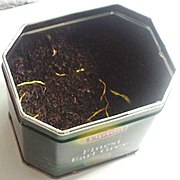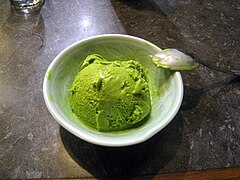Cookbook:Tea Leaves
| Tea Leaves | |
|---|---|
 | |
| Category | Herbs and spices |
Cookbook | Recipes | Ingredients | Equipment | Techniques | Cookbook Disambiguation Pages | Ingredients | Spices and herbs
Tea leaves, sometimes shortened to tea, are the processed leaves of Camellia sinensis. They are used to make the beverage tea.
Production
[edit | edit source]After harvest, the tea leaves undergo a withering process where they are allowed to wilt and soften—a small amount of oxidation takes place during this process. They are then rolled and broken up. The leaves are then spread in a cool, damp place and left to oxidize, which develops their flavor and color. Finally, the leaves are heated to halt oxidation, then fully dried and graded. The finished tea leaves may be blended or have additional flavorings/spices added.
Fully processed tea leaves and blends may be sold loose, pressed into cakes or bricks, or packaged into individual bags.
Types
[edit | edit source]By processing
[edit | edit source]Not all teas go through the full production process, and they are classified based on the extent to which they do:
- Green tea: Immediately dried; no withering or wilting
- White tea: Slightly withered before drying
- Oolong tea: Partially oxidized
- Black tea: Fully oxidized, very strong
Flavored teas
[edit | edit source]- Earl grey: Black tea flavored with bergamot
- Jasmine: Tea flavored with jasmine blossoms
- Chai: Black tea blended with a range of spices such as cinnamon, clove, pepper, and more
Other varieties
[edit | edit source]- Matcha: specialized variety of green tea grown in the shade; fibers are removed, and leaves are ground to a very fine powder
Use
[edit | edit source]Tea leaves are primarily used to make brewed tea and other tea-derived beverages. They are also used to flavor many sweets and desserts, such as ice creams, cakes, confections, custards, and more.
Gallery
[edit | edit source]-
Different grades of tea (left to right: green, white/yellow, oolong, black)
-
Tea packaged into bags
-
Loose tea sold in a tin
-
Matcha tea powder
-
Green tea ice cream




